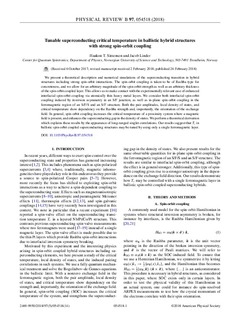| dc.contributor.author | Simensen, Haakon Thømt | |
| dc.contributor.author | Linder, Jacob | |
| dc.date.accessioned | 2019-03-29T11:58:29Z | |
| dc.date.available | 2019-03-29T11:58:29Z | |
| dc.date.created | 2018-02-26T20:23:07Z | |
| dc.date.issued | 2018 | |
| dc.identifier.citation | Physical Review B. 2018, 97 (5), 1-14. | nb_NO |
| dc.identifier.issn | 2469-9950 | |
| dc.identifier.uri | http://hdl.handle.net/11250/2592476 | |
| dc.description.abstract | We present a theoretical description and numerical simulations of the superconducting transition in hybrid structures including strong spin-orbit interactions. The spin-orbit coupling is taken to be of Rashba type for concreteness, and we allow for an arbitrary magnitude of the spin-orbit strength as well as an arbitrary thickness of the spin-orbit coupled layer. This allows us to make contact with the experimentally relevant case of enhanced interfacial spin-orbit coupling via atomically thin heavy metal layers. We consider both interfacial spin-orbit coupling induced by inversion asymmetry in an S/F-junction, as well as in-plane spin-orbit coupling in the ferromagnetic region of an S/F/S- and an S/F-structure. Both the pair amplitudes, local density of states and critical temperature show dependency on the Rashba strength and, importantly, the orientation of the exchange field. In general, spin-orbit coupling increases the critical temperature of a proximity system where a magnetic field is present, and enhances the superconducting gap in the density of states. We perform a theoretical derivation which explains these results by the appearance of long-ranged singlet correlations. Our results suggest that Tc in ballistic spin-orbit coupled superconducting structures may be tuned by using only a single ferromagnetic layer. | nb_NO |
| dc.language.iso | eng | nb_NO |
| dc.publisher | American Physical Society | nb_NO |
| dc.title | Tunable superconducting critical temperature in ballistic hybrid structures with strong spin-orbit coupling | nb_NO |
| dc.type | Journal article | nb_NO |
| dc.type | Peer reviewed | nb_NO |
| dc.description.version | publishedVersion | nb_NO |
| dc.source.pagenumber | 1-14 | nb_NO |
| dc.source.volume | 97 | nb_NO |
| dc.source.journal | Physical Review B | nb_NO |
| dc.source.issue | 5 | nb_NO |
| dc.identifier.doi | 10.1103/PhysRevB.97.054518 | |
| dc.identifier.cristin | 1568828 | |
| dc.description.localcode | ©2018 American Physical Society | nb_NO |
| cristin.unitcode | 194,66,20,0 | |
| cristin.unitname | Institutt for fysikk | |
| cristin.ispublished | true | |
| cristin.fulltext | preprint | |
| cristin.qualitycode | 2 | |
